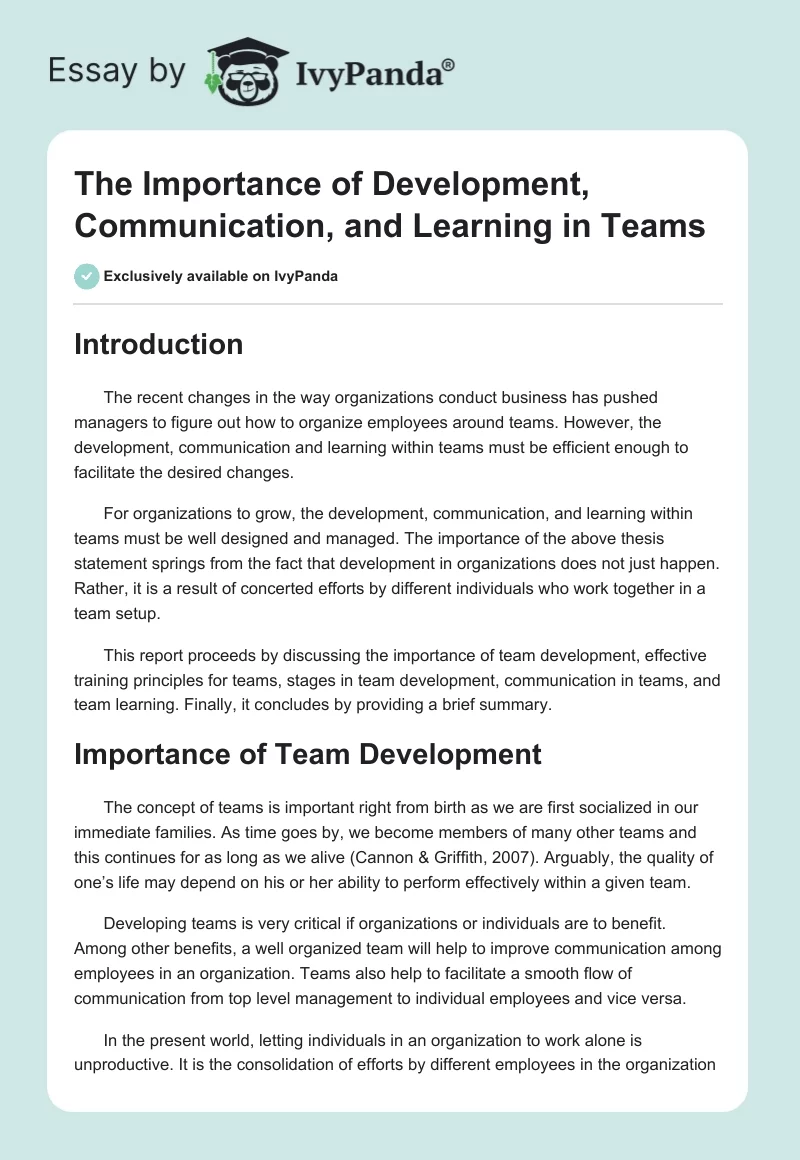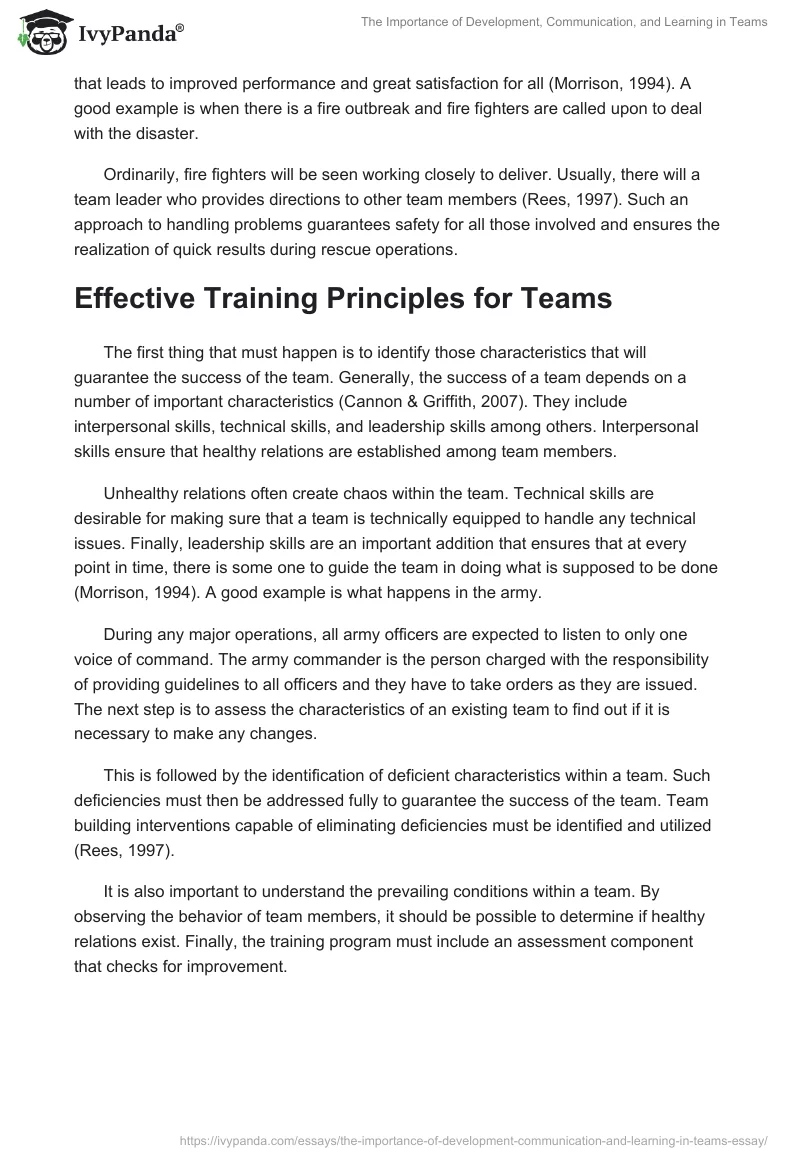Introduction
The recent changes in the way organizations conduct business has pushed managers to figure out how to organize employees around teams. However, the development, communication and learning within teams must be efficient enough to facilitate the desired changes.
For organizations to grow, the development, communication, and learning within teams must be well designed and managed. The importance of the above thesis statement springs from the fact that development in organizations does not just happen. Rather, it is a result of concerted efforts by different individuals who work together in a team setup.
This report proceeds by discussing the importance of team development, effective training principles for teams, stages in team development, communication in teams, and team learning. Finally, it concludes by providing a brief summary.
Importance of Team Development
The concept of teams is important right from birth as we are first socialized in our immediate families. As time goes by, we become members of many other teams and this continues for as long as we alive (Cannon & Griffith, 2007). Arguably, the quality of one’s life may depend on his or her ability to perform effectively within a given team.
Developing teams is very critical if organizations or individuals are to benefit. Among other benefits, a well organized team will help to improve communication among employees in an organization. Teams also help to facilitate a smooth flow of communication from top level management to individual employees and vice versa.
In the present world, letting individuals in an organization to work alone is unproductive. It is the consolidation of efforts by different employees in the organization that leads to improved performance and great satisfaction for all (Morrison, 1994). A good example is when there is a fire outbreak and fire fighters are called upon to deal with the disaster.
Ordinarily, fire fighters will be seen working closely to deliver. Usually, there will a team leader who provides directions to other team members (Rees, 1997). Such an approach to handling problems guarantees safety for all those involved and ensures the realization of quick results during rescue operations.
Effective Training Principles for Teams
The first thing that must happen is to identify those characteristics that will guarantee the success of the team. Generally, the success of a team depends on a number of important characteristics (Cannon & Griffith, 2007). They include interpersonal skills, technical skills, and leadership skills among others. Interpersonal skills ensure that healthy relations are established among team members.
Unhealthy relations often create chaos within the team. Technical skills are desirable for making sure that a team is technically equipped to handle any technical issues. Finally, leadership skills are an important addition that ensures that at every point in time, there is some one to guide the team in doing what is supposed to be done (Morrison, 1994). A good example is what happens in the army.
During any major operations, all army officers are expected to listen to only one voice of command. The army commander is the person charged with the responsibility of providing guidelines to all officers and they have to take orders as they are issued. The next step is to assess the characteristics of an existing team to find out if it is necessary to make any changes.
This is followed by the identification of deficient characteristics within a team. Such deficiencies must then be addressed fully to guarantee the success of the team. Team building interventions capable of eliminating deficiencies must be identified and utilized (Rees, 1997).
It is also important to understand the prevailing conditions within a team. By observing the behavior of team members, it should be possible to determine if healthy relations exist. Finally, the training program must include an assessment component that checks for improvement.
Stages in Team Development
The five stage of team development are forming, storming, norming, performing, and Adjourning (Cannon & Griffith, 2007). The forming stage involves the formation of the team. Usually, team members are happy at this point in time to be part of a new team and show full cooperation. Activities may include examining the behavior of members to determine what each person may be capable of doing once the team is in place.
The storming stage is mostly characterized by heated debates that can easily lead to serious disagreements if not managed properly. It is during the norming stage that team members sober up and begin to deal with varying opinions. At this stage, expectations of team members are leveled and they begin to accommodate each other opinions (Morrison, 1994).
The performing stage involves undertaking the actual tasks to realize agreed upon objectives of the team. After tasks have been performed, the adjourning stage comes next (Rees, 1997). This stage involves the termination of the teams after a task has been completed. An example can be seen in an organization that constitutes a team to deal with a common project.
Through the guidance of the team leader, the team will be expected to move through the different phases of operation till the end. Once the job has been done, the team is adjourned and members can return to their normal duties. However, the team may be requested to extend its life if there is need to do so. This must, however, be done in consultation with all the team members.
Communication in Teams
The communication in teams can be verbal or non-verbal (Morrison, 1994). While verbal communication is mainly through voicing one’s opinions or suggestions, non-verbal communication may take place through facial expressions, use of time and space, touching, gestures and postures, vocal characteristics, and personal appearance.
Regardless of the means of communication used, it is important to note that communication is what keeps a team active and focused on doing what has to be done.
Team Learning
Teams tend to learn best by engaging with each other constantly. One characteristic of a team is diversity. The diversity in a team creates an opportunity for all team members to learn from each other. Members who are good in a certain area may be given a chance to take charge of a session and share what they know with fellow team members (Cannon & Griffith, 2007).
This acts as a very good strategy of transferring tacit knowledge to team members and essentially, to the organization. A good example is where a team is constituted to design and deploy a network. Members who are more knowledgeable than others as far network configuration and deployment is concerned may be asked to take lead of the project and give direction to the rest (Morrison, 1994).
Those who are not familiar with some of the concepts can then take advantage of working alongside experienced team members and learn as much as they can. Apparently, this has been seen as the best approach to training members within an organizational setup.
In case the experienced member of the team leaves the organization, the organization may easily turn to the trained employee for a solution. This further ensures that knowledge that exists within individuals does not disappear with them when a time eventually comes for them to leave the organization.
Conclusion
As stated earlier, effective teams must be designed to support growth in an organization. Key design principles must be followed and communication and team learning must be enhanced at all costs. This report has looked at a number of concepts relating to teams and these are summarized here.
First, the importance of team development was discussed. Considering that the goal is to ensure effectiveness within an organization, the process of team development must be taken very seriously. Having a well designed team will benefit both the organization and individual members within the teams.
The report also looked at effective training principles that must be considered when constituting a team. In building teams, it is necessary to follow a systematic approach as explained in this report.
The different stages of team development have also been described and include forming, storming, norming, performing, and Adjourning stages. Each of these stages is responsible for at least one thing that relates to the development of the team.
Communication among team members has also been examined. Options available for communication within teams may be verbal or non-verbal. While non-verbal communication can easily be detected by other team members, verbal form of communication must be spoken.
Finally, team learning was looked at and various ways of learning discussed. As explained, the best approach to learning is for team members to learn from each other through sharing their expertise and experiences. Through the different subsections in this report, each of the questions asked in the assignment has been addressed.
References
Cannon, M. D. & Griffith, B. A. (2007). Effective Groups: Concepts and Skills to Meet Leadership Challenges. Boston: Pearson Education, Inc.
Morrison, E. K. (1994). Leadership Skills: Developing Volunteers for Organizational Success. USA: Fisher Books.
Rees, F. (1997). Teamwork from Start to Finish. San Francisco, California: Pfeiffer.


